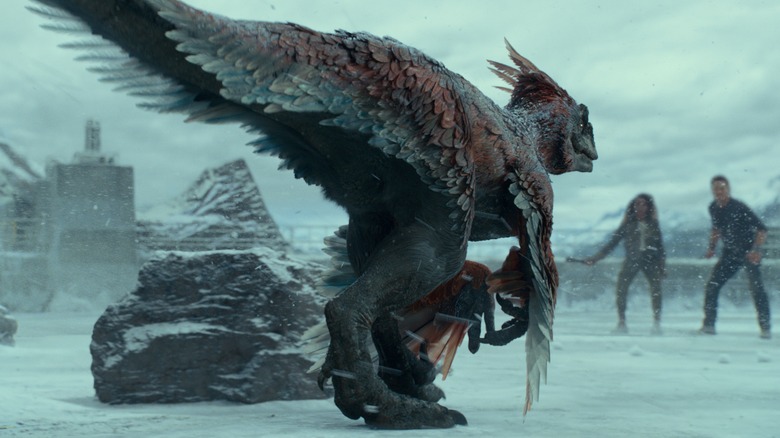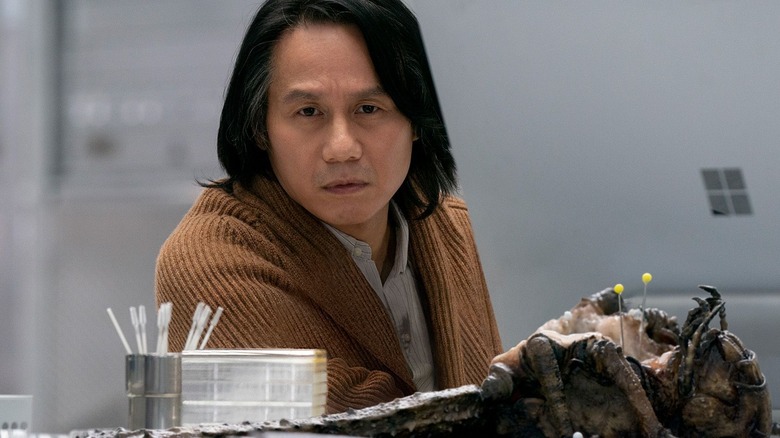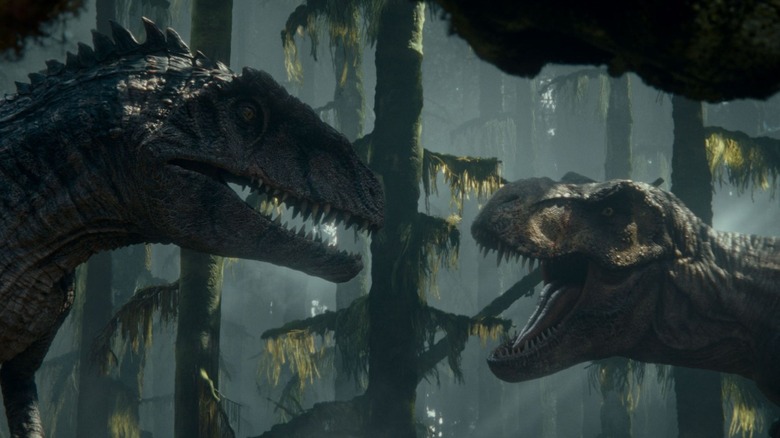How Jurassic World VFX Artists Use Real Science And Paleontology For Inspiration
The original "Jurassic Park" continues to be celebrated and recognized for countless reasons. Among them: Spielberg's fine-tuned direction, the frankly incredible VFX work that still holds up to this day, the cast of memorable characters, and the deeper theme of capitalism run amok that allow viewers the choice to enjoy it as either a thrilling blockbuster or a much richer and more meaningful cautionary text. What the franchise hasn't done well, on the other hand, probably keeps sticklers like Neil DeGrasse Tyson awake at night: scientific accuracy ... or, rather, the lack thereof.
Sure, it's not all bad. The first film rightfully posits a deep connection between dinosaurs and birds, the likely method of their extinction 65 million years ago at the wrong end of an asteroid impact, and even puts that snot-nosed kid in his place for daring to disrespect the sanctity of Velociraptors. Rightfully so! And yet, for all that, the franchise remains littered with inaccuracies and outright inventions, dictating the mainstream perception of how dinosaurs actually lived once upon a time. Sorry folks, there's no evidence that T-rex vision was based on movement, that Dilophosaurus ever had colorful fans and spat venom, or that Velociraptors were anywhere near as large or smart as depicted throughout the franchise. And don't even think about the logic of extracting usable dinosaur DNA from fossilized amber, either.
Simply put, realism or scientific truth has never been a chief priority in this franchise — but that didn't stop the creative team behind "Jurassic World Dominion" from taking their cues from actual science and paleontological insights anyway. As it turns out, that famous "65 million years in the making" tagline contained a kernel of truth to it.
'Getting the science right'
For as many creative liberties as these "Jurassic" movies have taken over the years in the pursuit of entertainment, the "Jurassic World Dominion" VFX crew decided that a new approach was needed to bring the terrifying, awe-inspiring, and oftentimes deadly dinosaurs to life. In an interview with Below the Line, ILM VFX Supervisor David Vickery ("Harry Potter and the Deathly Hallows," "Doctor Strange," "Jurassic World: Fallen Kingdom") gave a fascinating behind-the-scenes glimpse into the role that actual science played in the making of "Dominion."
"There's a lot of time and energy dedicated to getting the science right. I know 'Jurassic' dinosaurs have a certain aesthetic, which we fit into, but it's still really important for us that what we're doing is based on scientific reality. I remember on 'Fallen Kingdom,' one of our texture artists studied paleontology at university, so that was her background. She came to us as a paleontologist, and now she's working in visual effects."
"And then we have animators, and all they think about is how things actually perform and move and emote. They will reference real animals in those instances, like cassowaries or crocodiles and alligators or elephants ... when we go about designing a new creature, the first thing we look at are the holotype specimens and the fossils that are available for us, so we can sort of build them from the inside out."
Imagine studying to become a paleontologist ... only to end up in the movie business instead. With as many young kids who fell in love with dinosaurs as a result of the "Jurassic" movies, there's something poetic about "Dominion" recruiting folks with that specific background to make the movie monsters that much more convincing.
'We're not ignoring science at all'
Much like Steven Spielberg's blockbuster classic "Jaws," there's probably no undoing the damage to our pop culture assumptions of movie monsters like dinosaurs. At the very least, however, the recent sequels have gone out of their way to bring in a more accurate representation — to the best of our scientific knowledge, at least — of how these prehistoric behemoths once lived and moved as the dominant force on our planet all those millions of years ago. In the same interview, Vickers goes on to describe the collaborative nature of this process in "Jurassic World Dominion." Ensuring a reasonably accurate translation of dinosaurs was a multi-pronged effort.
"Kevin Jenkins, our production designer, the first thing he does with the concepts of these new creatures, is employ paleo artists to try to design and depict the creatures. And then we've got Steve Brusatte, who is our consultant paleontologist. He sees all these concepts and he says, 'You know what? Of course, that could be great,' or 'This is a bit big or small or actually, the nose of the skull would be a little bit squatter than that.' So we're not ignoring science at all, we're really embracing it, and then trying to see how we can fit that within the 'Jurassic' franchise."
While this franchise hasn't quite lived up to the critical acclaim of the original film, there's simply no denying the effort poured into the technical aspects of turning all those zeroes and ones into photorealistic and formidable beasts. Next time you sit down to watch one of these movies, consider the possibility that the research gained from a remote paleontological dig site may have found its way to the screen in the neatest way possible.


